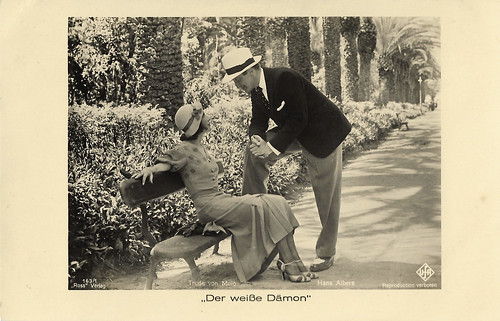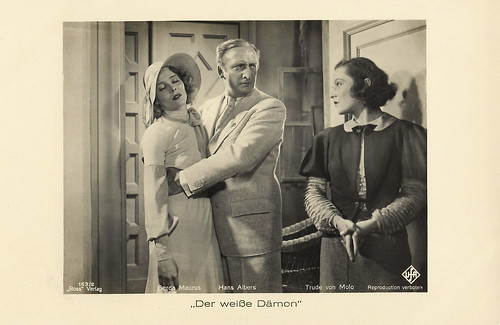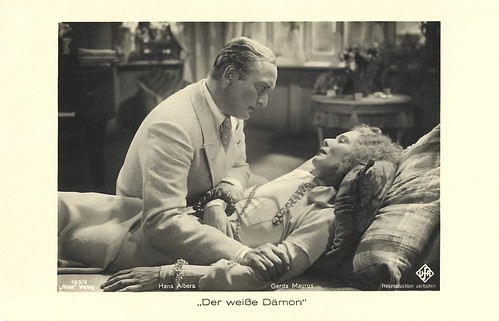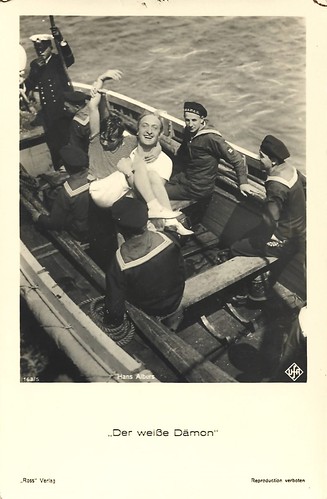
German postcard by Ross Verlag, no. 7039/1, 1932-1933. Photo: Ufa. Hans Albers in Der weiße Dämon/Dope (Kurt Gerron, 1932).

German Postcard by Ross Verlag, no. 163/1, 1932-1933. Photo: Ufa. Hans Albers and Trude von Molo in Der weiße Dämon/Dope (Kurt Gerron, 1932).
A drug called the White Demon
The script of Der weiße Dämon/Dope (Kurt Gerron, 1932) was written by Philipp Lothar Mayring and Fritz Zeckendorf. Alfred Abel plays Consul Gorre, the head of an international gang of drug smugglers that also includes the morphine-addicted theatre director Urussev (Raoul Aslan), the Marquis d'Esquillon (Hubert von Meyerinck), section chief of the gang in Paris, and a man known only as "the Hunchback" (Peter Lorre) who is responsible for importing the narcotics from overseas.
The gang of criminals travels under the guise of an internationally performing touring theatre troupe, joined as a leading lady by the young artist Gerda Gildemeister (Gerda Maurus). Gerda's brother is the "Hamburg boy" Heini Gildemeister (Hans Albers) who, after years of absence spent in South America, finally returns to his hometown by ship. On this journey home, he rescues Gorre's son after he had fallen overboard.
Back home, Heini makes a terrible discovery: Sister Gerda is only a wreck, very weak and ailing in body, mind and soul. Years of morphine abuse have taken their toll on her. She has become completely dependent and can hardly get back on her feet without this drug, also called the "white demon". Heini discovers a corresponding syringe in the pocket of Dora (Trude von Molo), a friend of Gerda's, and receives confirmation from the theatre doctor that his sister has become a dependent morphine addict through years of drug use. Heini immediately takes her to the nearest hospital. But since Gerda is supposed to travel to Paris the next day as part of a tour, the gang members are immediately on the scene and get her out of the hospital. They force Gerda to call her brother and summon him to a meeting in a pub that has a reputation as a drug bar.
When Heini appears there, the gang tries to overpower the "troublemaker", but he manages to free himself and now takes up the pursuit of the gang on his own, as the police who were informed earlier is of no real help. Heini is determined to prevent Gerda from staying in the custody of the unscrupulous dealers even one day longer. But Heini fails in this because Gerda goes to the French capital for a singing performance with the theatre troupe, where she is held in the Marquis' house. The Marquis explains to Heini that Gerda (delirious with fever, as it turns out) has forged a bill of exchange - in the hope that Heini will finally give in so as not to let his sister go to prison.
Consul Gorre, who has been in Heini's debt ever since his son was rescued on the overseas steamer, helps him to free Gerda so that Heini can immediately take her to a sanatorium. But Heini still does not know who the ostensible ally really is. Gildemeister does not let up and follows the gang of criminals. In Lisbon, he manages to get "the hunchback" arrested, while Urusev, who betrayed his buddies, is shot. On the flight home with Dora and Gorre, Heini now also exposes the ominous consul as the head of the gang. With suicidal intent, he then throws himself into the Atlantic. Heini and Gerda's artist colleague Dora, with whom he has become friends in the meantime, return to Hamburg as friends for life.

German Postcard by Ross Verlag, no. 163/2, 1932-1933. Photo: Ufa. Hans Albers, Trude von Molo and Gerda Maurus in Der weiße Dämon/Dope (Kurt Gerron, 1932).

German postcard by Ross Verlag, no. 613/3, 1932-1933. Photo: Ufa. Hans Albers and Gerda Maurus in Der weiße Dämon/Dope (Kurt Gerron, 1932).
Dope
Der weiße Dämon/Dope (Kurt Gerron, 1932) was shot from 20 June until August 1932 in Portugal and Spain as well as on the Hapag steamer Emil Kirdorf, in Cuxhaven harbour and on the MS General Osorio (the exterior shots). The premiere took place on 19 November 1932 in Berlin's Ufa-Palast am Zoo.
The film was originally supposed to be called Rauschgift (Dope), but this title caused considerable problems with the German film censors, who feared that the film would advertise drugs. According to a decision of 10 November 1932, corresponding scenes had to be deleted. In Austria, however, the film title Rauschgift was approved.
Julius von Borsody designed the film sets, Günther Anders assisted chief cameraman Carl Hoffmann. Hermann Hoffmann designed the costumes, Erich Holder assisted director Kurt Gerron. Walter Rühland provided the sound. In the cast was the former star of the early silent film, Eva Speyer. She played her last film role here, a very small role. Karl John in turn made his film debut here.
Simultaneously with the original German production, the Ufa made a French version with Jean Murat in the role of Hans Albers under the title Stupéfiants/Narcotics (Kurt Gerron, Roger Le Bon, 1932). In the cast were also Danièle Parola, Jean Worms, Jean Mercanton and Monique Rolland. Raoul Aslan and Peter Lorre repeated their roles from the German version. In contrast to Lorre, director Kurt Gerron, one of the greats of Weimar cinema, theatre and vaudeville, could not escape the Nazis. Gerron was murdered in Auschwitz in 1943.
Trade journal Der Film wrote: "The director Kurt Gerron ... lets the events take their fabulous course and fabulates happily along, out of actor's whim. (...) He uses his only trump cards and knows how to exploit them the fiercely extemporising Albers, who lives it up, ... the excellent Lorre, who plays with gripping demeanour, ... the this time surprisingly good Gerda Maurus...". However, future Minister of Propaganda Joseph Goebbels wrote in his diary entry of 21 November 1932: "Albers a fabulous boy. Otherwise a piece of rubbish."

German Postcard by Ross Verlag, no. 163/4, 1932-1933. Photo: Ufa. Hans Albers and Trude von Molo in Der weiße Dämon/Dope (Kurt Gerron, 1932).

German postcard by Ross Verlag, no. 163/5, 1932-1933. Photo: Ufa. Hans Albers in Der weiße Dämon/Dope (Kurt Gerron, 1932).
Sources: Zeughauskino (German), Filmportal.de, Wikipedia (German and English) and IMDb.
No comments:
Post a Comment